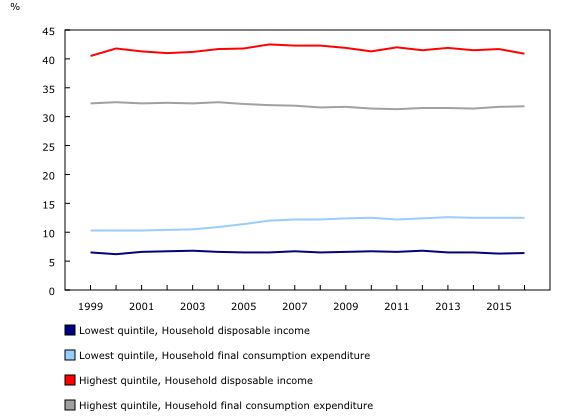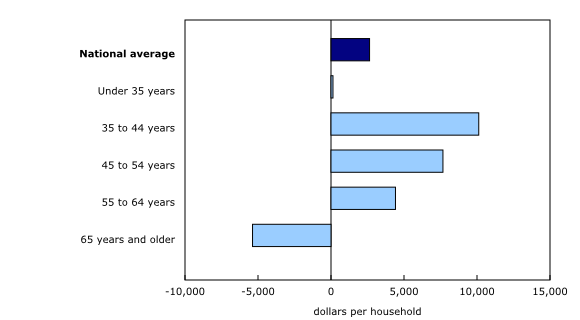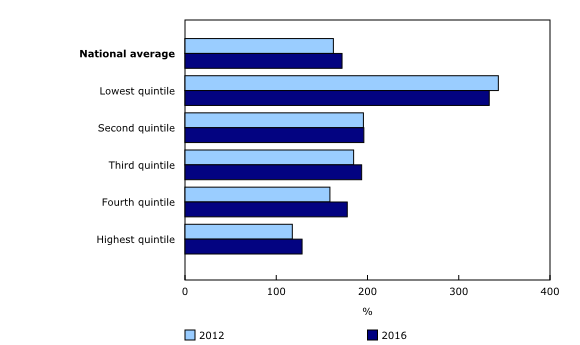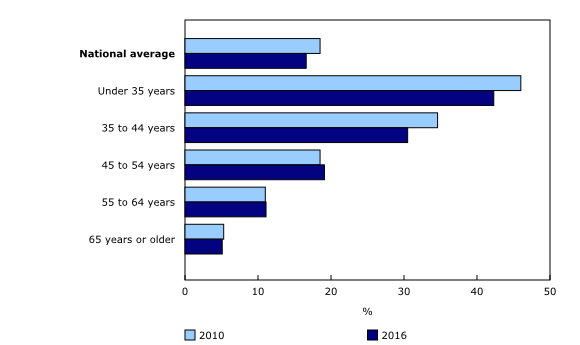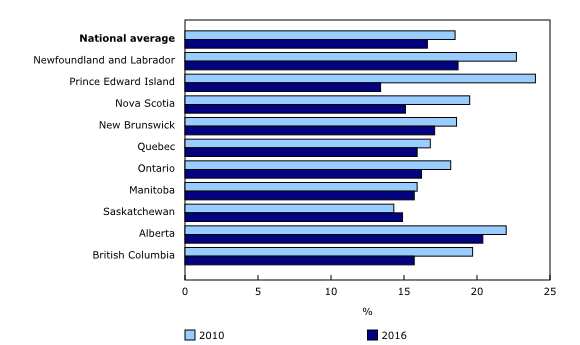Distributions of household economic accounts for income, consumption, saving and wealth of Canadian households, 2016
Archived Content
Information identified as archived is provided for reference, research or recordkeeping purposes. It is not subject to the Government of Canada Web Standards and has not been altered or updated since it was archived. Please "contact us" to request a format other than those available.
Released: 2017-12-14
Wealth, income and consumption concentrated among top earning households
New estimates for the distributions of household disposable income, final consumption expenditure, net saving and wealth indicate that households in the top disposable income quintile held 48.9% of total household wealth, while the bottom disposable income quintile held 5.8% in 2016.
The share of the top quintile's wealth has remained relatively unchanged since 2010, when this group held 50.1% of total household wealth.
The distribution of disposable income across Canadian households was also concentrated in the top quintile in 2016. Similar to wealth, the top 20% of income earning Canadian households accounted for 40.9% of total household disposable income. Compared with the entire Canadian economy, these households accounted for 23.5% of total gross national income accruing to Canadians from all sources.
The distribution of household final consumption expenditure shows less disparity between the top and bottom quintiles than that of wealth and income, as the share of households in the top income quintile for total final consumption in goods and services was 31.8% in 2016 compared with 12.5% for the bottom income quintile.
Estimates related to the distributions of household disposable income and final consumption expenditure extend back to 1999. Similar to wealth—the distribution of total final consumption expenditure by quintile across Canadian households has not changed significantly over the years. The share of total final consumption expenditure among the top 20% income earning households has ranged from 32.5% in 2000 and 2004 to 31.3% in 2011.
Younger households are net savers while older households are net dis-savers
Age is also a key determinant of household disposable income, final consumption expenditure and net saving. Households with a major income earner aged 65 or older are net dis-savers, as the majority of individuals are drawing down their wealth, such as their pension assets, rather than earning wages and salaries. In 2016, households with a major income earner under 35 years years old saved $134 per household, compared with those aged 65 or older who had net dis-savings (-$5,374).
Debt-to-disposable-income and debt-to-asset ratios vary by household
Economy-wide debt-to-asset and debt-to-disposable-income ratios can mask the financial risk associated with increasing debt for a given group of Canadian households. In 2016, the national average debt-to-disposable-income ratio was 172.1%. Decomposing this by household disposable income quintile reveals that the debt-to-disposable-income ratio for the bottom income earning households was 333.4%, while the debt-to-disposable-income ratio for the top was 128.3%. From 2012 to 2016, the ratio has increased significantly for the higher income quintiles, who have seen debt increase faster than income over this period.
The debt-to-disposable-income ratio is one measure of financial risk. A more important measure is the debt-to-asset ratio, which indicates the degree of leverage a household has in relation to its debt. The greater the debt leverage, the more susceptible a household may be to financial vulnerabilities in the future. On the other hand, as asset prices increase (such as land and financial assets like equities), households are able to secure more debt without increasing their leverage.
Overall, households improved their capacity to finance debt, illustrated by owner's equity as a percentage of real estate, which has risen from 72.3% to 74.7% since 2010. This ratio increases with income, with households in the lowest income quintile at 67.6% and those in the highest at 80.4% in 2016.
Compared with the national average debt-to-asset ratio of 16.6%, the debt-to-asset ratio for the top income quintile was 11.1%, while it was 21.3% for the middle (third) quintile and 29.1% for the bottom quintile.
The differences were more telling by age group, as younger Canadian households had a much higher debt-to-asset ratio than older households.
Consistent with a pattern of wealth accumulation over the life cycle, households tend to accumulate assets and pay down debt over their lifetimes. In 2016, the debt-to-asset ratio was 42.3% for households with a major income earner aged under the age of 35, while the 65 years of age or older group had a debt-to-asset ratio of 5.1%.
Households in Alberta have highest debt-to-asset ratios
Over the last several years, households in Alberta have had the highest debt-to-asset ratio of any province in Canada. In 2016, the debt-to-asset ratio was 20.4% in Alberta. Since 2012, this ratio decreased at a slower pace than the national average, as growth in the value of real estate in Alberta was lower than the national average growth in real estate.
Since 2010, most provinces outside the Prairies improved their debt-to-asset ratios at a faster pace than the national average. For example, from 2010 to 2016, a stronger than average decrease occurred for households in British Columbia (-4.0 percentage points) and Atlantic Canada (-3.7 percentage points).
The debt-to-asset ratio for households in British Columbia fell more steeply than for other provinces, as the value of real estate as a share of total assets increased by 3.7 percentage points, compared with a 1.0 percentage point increase in the national average from 2010 to 2016. Households in Atlantic Canada, on the other hand, had stable or decreasing mortgage debt, while growth in real estate values has been low relative to the national average since 2010.
Note to readers
Statistics Canada regularly publishes macroeconomic indicators on household disposable income, final consumption expenditure, net saving and wealth as part of the Canadian System of Macroeconomic Accounts (CSMA). These accounts are aligned with the most recent international standards and are compiled for all sectors of the economy, including households, non-profit institutions, governments and corporations along with Canada's financial position vis-a-vis the rest of the world.
While the CSMA provide high quality information on the overall position of households relative to other economic sectors, the Distributions of Household Economic Accounts provide needed granularity to address questions such as vulnerabilities of specific groups and the resulting implications for economic wellbeing and financial stability, and are an important complement to standard quarterly outputs related to the economy.
Indicators cited in this release include: household disposable income quintiles, which are equivalized (adjusted) to the number of consumption units per household; net saving, derived from household disposable income less household final consumption expenditure plus the change in the value of pension entitlements; measures of household financial risk, including the debt-to-disposable-income ratio and the debt-to-assets ratio; and owner's equity as a percentage of real estate, an indicator of households' vulnerability to changes in the value of real estate, and their ability to incur debt for consumption purposes, as equity in property is often used as collateral for consumer lines of credit.
Products
Details on the sources and methods behind these estimates can be found in Methodological Guide: Canadian System of Macroeconomic Accounts (13-607-X). See section "Distributions of Household Economic Accounts" under Satellite Accounts and Special Studies.
The Latest Developments in the Canadian Economic Accounts (13-605-X) is available.
The User Guide: Canadian System of Macroeconomic Accounts (13-606-G) is available.
The System of Macroeconomic Accounts module features an up-to-date portrait of national and provincial economies and their structure.
Contact information
For more information, contact us (toll-free 1-800-263-1136; 514-283-8300; STATCAN.infostats-infostats.STATCAN@canada.ca).
- Date modified:


